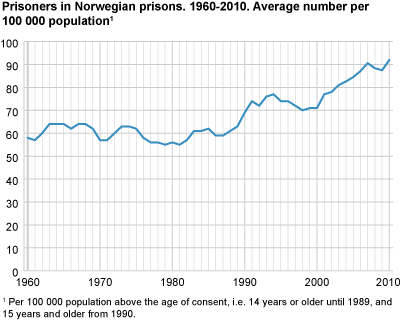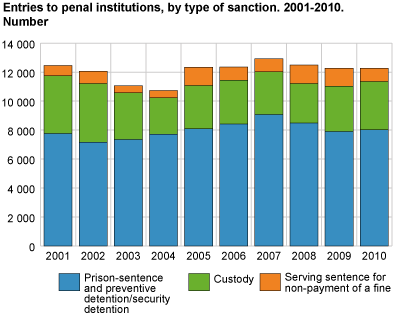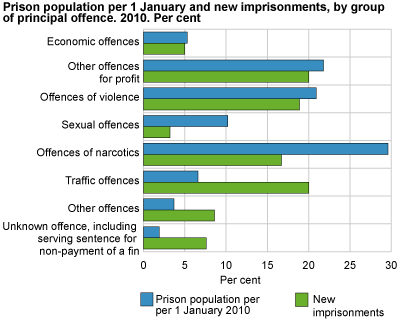Content
Published:
This is an archived release.
More and longer custody imprisonments
On average, there were 3 624 prisoners per day in Norwegian prisons in 2010. This is 7 per cent more than the year before, and more than in any of the past 50 years. In addition, more sentences are now being served by means of electronic monitoring outside prisons.
In the historical statistics dating back to 1960, there is no year with such a high average number of prisons in Norwegian prisons than in 2010, and this is also still the case if we account for the increase in population in these years (see figure). On an average day in 2010, 2 484 persons were serving a prison sentence, 71 were in preventive detention, 77 were serving sentences for non-payment of a fine and 993 persons were in custody. Compared with the previous year, there were almost 3 per cent more persons serving a prison sentence and 24 per cent more in custody. This was concurrent with an increase in prison capacity after the opening of Halden prison (see textbox).
Just as many imprisonments started in prison as in 2009
In 2010, 7 675 new imprisonments for serving penal sentences were registered in Norwegian prisons. In addition, 1 410 transfers were made directly from custody to serving prison sentences in 2010, and compared with the previous year, 3 per cent more prison sentences began overall. Much of this increase, however, is related to greater use of electronic monitoring as a way of serving a sentence outside prison (see textbox).
More new imprisonments to custody, but fewer serving sentences for non-payment of a fine
In total, there were 11 881 new imprisonments in 2010, which is almost as many as in 2009. Custody made up 28 per cent of all new imprisonments in 2010, and the 3 327 custody imprisonments constituted 6 per cent more than in 2009. The fact that there was no increase in the total number of new imprisonments is due to the considerable reduction in the number of new imprisonments for non-payment of a fine - from 1 182 in 2009 to 879 in 2010.
More spending long periods in custody
The increase in the average number of prisoners, without a corresponding increase in the number of entries and departures, seems to be related to the fact that more prisoners are spending long periods in prison. For example, 1 388 of the completed custody imprisonments in 2010 lasted for 60 days or more. This is over 18 per cent more than in 2009, and 35 per cent more than in 2008.
Narcotics main reason for serving sentence and custody
Almost 30 per cent of prisoners at the beginning of the year had a narcotics offence as a principal offence. By comparison, offences for profit constituted 22 per cent and offences of violence made up 21 per cent. Of those in custody, 32 per cent had a narcotics offence as a principal offence, while 29 per cent had larceny or other offence for profit. Most of the 68 persons in preventive detention at the beginning of 2010 had offences of violence (54 per cent) or sexual offences (35 per cent) as a principal offence.
Highest share of new imprisonments for offences for profit or traffic offences
Offences of those who come into prisons in a single year (new imprisonments) are relatively different to those we see among persons who are in prison at any given time. This is partly because a relatively larger share of the new imprisonments has short sentences. Twenty per cent of new imprisonments in 2010 had a traffic offence as the principal offence, while the share among prisoners at the beginning of the year was less than 7 per cent. On the other hand, narcotics offences were the principal offence for a much lower share of new imprisonments (almost 17 per cent) than among those who were incarcerated at the beginning of the year (see figure).
Half of those detained at home have committed a traffic offence
On 1 January 2010, 47 prisoners were serving prison sentences by means of electronic monitoring. In 2010 as a whole, there were 891 direct entries to electronic monitoring and 919 direct departures from electronic monitoring. This means that almost 12 per cent of all new imprisonments in 2010 were commencements of electronic monitoring. The corresponding share of all discharges from prison sentences was almost 11 per cent. Those who served prison sentences using electronic monitoring in the period 2008-2010 had a variety of principal offences, but breaches of traffic legislation made up a much larger share than among prisoners in penal institutions.
| Group of offence | 2008 | 2009 | 2010 | ||||||||||||||||||||||||||||||||||||||||||||||||||||||||||||||||||||||||||||
|---|---|---|---|---|---|---|---|---|---|---|---|---|---|---|---|---|---|---|---|---|---|---|---|---|---|---|---|---|---|---|---|---|---|---|---|---|---|---|---|---|---|---|---|---|---|---|---|---|---|---|---|---|---|---|---|---|---|---|---|---|---|---|---|---|---|---|---|---|---|---|---|---|---|---|---|---|---|---|---|
| All types of offences | 95 | 705 | 887 | ||||||||||||||||||||||||||||||||||||||||||||||||||||||||||||||||||||||||||||
| Economic offences | 7 | 76 | 71 | ||||||||||||||||||||||||||||||||||||||||||||||||||||||||||||||||||||||||||||
| Other offences for profit | 18 | 95 | 130 | ||||||||||||||||||||||||||||||||||||||||||||||||||||||||||||||||||||||||||||
| Offences of violence | 2 | 55 | 59 | ||||||||||||||||||||||||||||||||||||||||||||||||||||||||||||||||||||||||||||
| Sexual offences | 0 | 4 | 2 | ||||||||||||||||||||||||||||||||||||||||||||||||||||||||||||||||||||||||||||
| Offences of narcotics | 5 | 56 | 76 | ||||||||||||||||||||||||||||||||||||||||||||||||||||||||||||||||||||||||||||
| Traffic offences | 58 | 372 | 477 | ||||||||||||||||||||||||||||||||||||||||||||||||||||||||||||||||||||||||||||
| Other offences 1 | 5 | 47 | 72 | ||||||||||||||||||||||||||||||||||||||||||||||||||||||||||||||||||||||||||||
| 1 | Including damage to property, environment offences and work environment offences. |
New prison in HaldenMany of the tables in the statistics on prisons have been impacted by the opening of Halden prison in 2010. The prison was opened on 1 March 2010, with 56 places, after which the prison gradually increased its capacity to 248 places by 31 December 2010 - according to the Norwegian Correctional Services’ annual statistics for 2010. These statistics also showed that Halden prison had a total of almost 50 000 prison stays, which corresponds to an average of 136 inmates in 2010. |
Electronic monitoring, a new way of serving unconditional punitive sentencesThe serving of punitive sentences by means of electronic monitoring (also known as “home detention with an ankle tag”) was introduced as an experimental arrangement on 1 September 2008 in 6 counties. Under section 16, paragraph 2 of the Act relating to criminal registration, this form of detention can be used for convicts with an unconditional sentence of up to four months (for the duration of the sentence), or for prisoners who have up to four months remaining until their expected release on parole (partial use of electronic monitoring).
Those who serve either all or part of their sentence using electronic monitoring are included in the statistics on prisoners at the beginning of the year, entries (including new imprisonments) and departures (including discharges) as from 2008. The use of electronic monitoring is now so extensive that this arrangement is crucial to the interpretation of these prison statistics, and particularly in relation to the changes that took place between 2008 and 2009. Those who serve either all or part of their sentence using electronic monitoring are not included in the statistics on the number of days spent in penal institutions in the year or figures on average numbers of prisoners. |
Contact
-
Susanne Fjelldalen
E-mail: susanne.fjelldalen@ssb.no
tel.: (+47) 40 90 26 43
-
Kristin Bergvall
E-mail: kristin.bergvall@ssb.no
tel.: (+47) 92 66 55 13
-
Reid Jone Stene
E-mail: reid.jone.stene@ssb.no
tel.: (+47) 99 02 22 01



